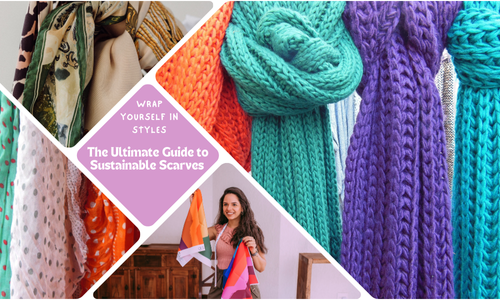This site may contain links to affiliate websites, and I may earn a commission for any purchases made through those links at no additional cost to you.

Wrap Yourself in Style: The Ultimate Guide to Sustainable Scarves
Scarves are not only a practical accessory but also a powerful statement of style and sustainability. As the fashion industry increasingly embraces eco-friendly practices, sustainable scarves have emerged as a popular choice for conscious consumers. This guide will delve into the world of sustainable scarves, exploring their benefits, materials, styling tips, and how to incorporate them into your wardrobe while making a positive impact on the planet.
Understanding Sustainable Scarves
Sustainable scarves are crafted with the environment in mind. They are made from eco-friendly materials and produced through ethical practices that prioritize the well-being of workers and the planet. Here are some key characteristics that define sustainable scarves:
Eco-Friendly Materials
Sustainable scarves are typically made from materials that have a lower environmental impact. Common fabrics include:
Organic Cotton: Grown without harmful pesticides or fertilizers, organic cotton is a breathable and soft option suitable for various climates.
Recycled Materials: Scarves made from recycled fibers, such as recycled polyester or wool, help reduce waste and promote a circular economy.
Natural Fibers: Materials like linen, Tencel, alpaca, and responsibly sourced wool are not only sustainable but also durable and stylish.
Non-Toxic Dyes: Sustainable scarves are often dyed using eco-friendly, non-toxic dyes that minimize environmental harm.
Ethical Production
The production of sustainable scarves often involves fair trade practices, ensuring that artisans and workers are treated ethically and compensated fairly. This includes safe working conditions and a commitment to social responsibility. Many sustainable brands are certified by organizations that uphold these standards, providing consumers with peace of mind about their purchases.
The Benefits of Choosing Sustainable Scarves
Opting for sustainable scarves offers numerous benefits, both for you and the environment:
1. Environmental Impact: By choosing scarves made from eco-friendly materials and produced through ethical practices, you are reducing your carbon footprint and supporting sustainable fashion.
2. Quality and Durability: Sustainable scarves are often made with high-quality materials that are designed to last. This results in fewer replacements and reduces waste over time.
3. Unique Designs: Many sustainable brands focus on craftsmanship and unique designs, allowing you to express your personal style while supporting ethical practices.
4. Support for Artisans: Purchasing sustainable scarves often means supporting small-scale artisans and communities, helping to preserve traditional crafts and promote economic development.
Styling Your Sustainable Scarves
Sustainable scarves can be styled in numerous ways, making them a versatile addition to any wardrobe. Here are some creative ideas for incorporating them into your outfits:
The Classic Wrap
A timeless way to wear a scarf is to wrap it around your neck. This style is suitable for both casual and formal events. Simply drape the scarf around your neck, allowing one end to hang longer than the other, and wrap the longer end around your neck for added warmth and style.
The Chic Knot
For a polished look, try tying your scarf in a knot. This works beautifully with both long and square scarves. Fold the scarf into a triangle, place it around your neck with the point facing down, and tie the ends in a knot at the front for a sophisticated touch.
The Headscarf
Scarves can also be worn as head accessories, adding a bohemian flair to your outfit. Fold the scarf into a long strip and tie it around your head, securing it at the back or side. This style is perfect for keeping hair in place while making a fashion statement.
The Belted Scarf
For a unique twist, use a scarf as a belt. Wrap it around your waist over a dress or oversized sweater, tying it in a knot or bow to create a flattering silhouette. This introduces a vibrant splash of color and texture to your ensemble.
Caring for Your Sustainable Scarves
To ensure your sustainable scarves remain in excellent condition, proper care is essential. Here are a few suggestions for preserving their quality:
Washing: Always check the care label for washing instructions. Hand washing is often gentler, especially for delicate fabrics like silk and cashmere.
Storage: Store scarves in a cool, dry place away from direct sunlight to prevent fading. Hanging them on a scarf hanger or rolling them up can help maintain their shape.
Avoiding Damage: Be mindful of snagging on jewelry or rough surfaces. Promptly repair small snags or loose threads to extend the lifespan of your scarves.
Where to Find Sustainable Scarves
Finding sustainable scarves has never been easier, thanks to the growing number of eco-conscious brands. You can explore various options, including:
Online Retailers: Many sustainable brands have online shops where you can browse their collections and read about their ethical practices.
Thrift Stores: Shopping second-hand is a fantastic way to find unique scarves while reducing waste. Thrift stores often have a wide variety of styles and materials.
Local Markets: Supporting local artisans at craft fairs or farmers’ markets can lead you to beautiful, handmade sustainable scarves.
Conclusion
Sustainable scarves are a stylish and responsible choice for anyone looking to enhance their wardrobe. By choosing eco-friendly materials and supporting ethical production practices, you can make a positive impact on the environment while enjoying the versatility and beauty of scarves. Whether you’re wrapping up for winter or adding a pop of color to your outfit, sustainable scarves offer endless possibilities for style and expression. So go ahead, wrap yourself in style and sustainability!




